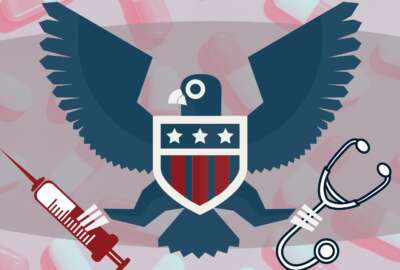
Federal employees will pay 8.7% more, on average, toward 2023 health premiums
On average, enrollees in the Federal Employees Health Benefits Program (FEHBP) will pay 8.7% more toward their 2023 premiums, the Office of Personnel Management...
Best listening experience is on Chrome, Firefox or Safari. Subscribe to Federal Drive’s daily audio interviews on Apple Podcasts or PodcastOne.
Participants in the Federal Employees Health Benefits Program (FEHBP) will see a significantly larger increase to their health premium costs in 2023, compared with the last few years.
Federal employees and retirees, on average, will pay 8.7% more in health premiums, the Office of Personnel Management announced on Sept. 30.
This year’s upcoming open season runs Nov. 14 to Dec. 12. During that time, FEHBP participants can make changes to their health, dental and vision plans for the upcoming benefit year, which begins on Jan. 1. FEHBP participants can see more details about the rates on OPM’s website.
The stark jump in costs is largely due to the timeline of the COVID-19 pandemic, according to OPM. At the start of the pandemic, the use of elective FEHBP benefits dropped off significantly, resulting in a lower average increase over the past four years. Now, a couple years into the pandemic, more enrollees are using their elective benefits, meaning the premium rates have jumped up as well. The cost of prescription drug prices also contributed to the increase.
The 8.7% bump is only an average for enrollees in the FEHBP. Individual federal employees and retirees may end up paying either more or less, depending on the plans they choose.
Overall, FEHBP premiums for non-postal employees and annuitants will increase 7.2% for 2023. The government will contribute 6.6% more toward premiums, making this year the highest increase since 2011.
To break it down, non-postal FEHBP participants will pay, on average, in 2023:
- Self-only coverage: $8.11 more per biweekly pay period,
- Self-plus-one coverage: $20.34 more per biweekly pay period,
- Family coverage: $20.87 more per biweekly pay period.
A formula under law defines the breakdown of contributions to the premium rate, split between enrollees and the government. The government covers about 75% of an FEHBP participant’s premium, but only up to a certain cap. That cap amounts to 72% of the weighted average of the last year’s premiums.
The premium rates change every year, but they always increase in some capacity. Last year, for example, rates increased by 3.8%, while back in 2019, the rates jumped by a slim 1.5%. And in 2016, enrollees paid about 6.4% more.
Federal unions and employee organizations said the sharp increase may cause surprise and displeasure for participants.
“These premium increases may be similar to those expected by other large employers in the private sector, but they will still cause sticker shock for federal employees,” said National Treasury Employees Union National President Tony Reardon. “NTEU encourages our members to prepare for price increases and use the upcoming open enrollment season to evaluate all of their options to decide which plan is best for themselves and their families.”
“I have no doubt that federal retirees and employees will react to today’s announcement
with disappointment and concern. This will be the highest increase in FEHB premiums
since 2011, and it comes as enrollees must deal with high inflation across the board. The
average increase in the enrollee share of premiums — 8.7% — is even more worrisome. It
may bring little comfort that these increases are comparable to premiums for plans from
other large employers,” said NARFE National President Ken Thomas.
Plan options for 2023
There are 271 plan choices for 2023, four fewer than last year’s total options. Not all participants have access to all the different plan options, though, as some options have regional limitations.
Out of those options, there are 18 fee-for-service plans, including 14 nationwide plans open to all participants. The other four fee-for-service plans are only available to certain limited groups.
Enrollees can also look at 37 high-deductible health plans, with two being available nationwide, as well as 28 consumer-driven health plans.
There will be 188 health maintenance organization (HMO) plans in 2023, compared with the 192 options available last year.
OPM added one new FEHBP carrier, Indiana University Health Plan, Inc., which will offer one plan. There are also four new plan choices among the existing FEHBP carriers for 2023.
Participants will soon be able to use the FEHBP plan comparison tool to compare different plan options.
OPM made some changes to covered services this year, too. Participants will see expanded telehealth options in 2023, including virtual mental health services, at low or no cost sharing. For health costs related to COVID-19, enrollees will have access to expanded coverage and services, including over-the-counter COVID-19 tests, vaccine booster shots and therapeutics.
Enrollees will see expanded coverage for maternal health as well. Some plan options now have more coverage in support of prenatal and postpartum care, including childbirth classes, group care, home visiting programs and care for high-risk pregnancies. The efforts aim to address inequalities in maternal health.
There will also be options for assisted reproductive technology (ART), as well as coverage of FDA-approved anti-obesity medications.
Dental, vision and more
In comparison to the 8.7% jump for health premiums, the average premium rate increases for the Federal Employees Dental and Vision Insurance Program (FEDVIP) are marginal for 2023.
Overall, premiums will increase, on average, by 0.2% for dental plans, and by 0.41% for vision plans.
For 2023, there are 23 dental plan options available across 12 carriers. Of those options, 14 plans across seven different carriers are available to all enrollees.
For vision, all participants can choose between 10 nationwide plans from five different carriers.
Participants can find more information ahead of open season at Benefeds.com for dental and vision plan options.
Additionally, participants must reenroll if they want to continue contributions to the Federal Flexible Spending Account Program (FSAFEDS). The program puts pre-tax dollars toward health care costs for both enrollees and their dependents.
By the start of open season on Nov. 14, participants will be able to find more information at the following OPM websites:
FEHB Quality Healthcare Scores
Federal Flexible Spending Account Program (FSAFEDS)
Copyright © 2025 Federal News Network. All rights reserved. This website is not intended for users located within the European Economic Area.
Drew Friedman is a workforce, pay and benefits reporter for Federal News Network.
Follow @dfriedmanWFED
Related Stories





